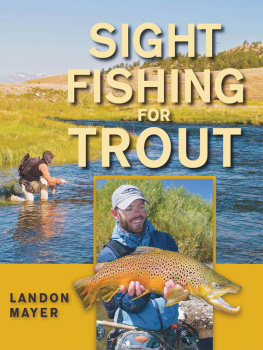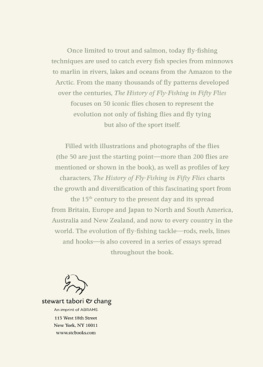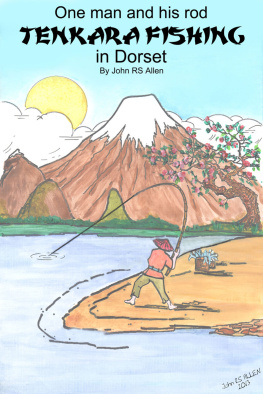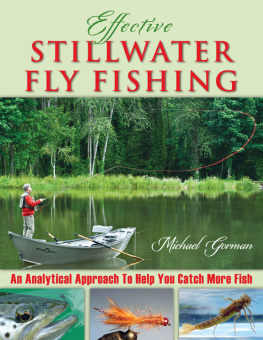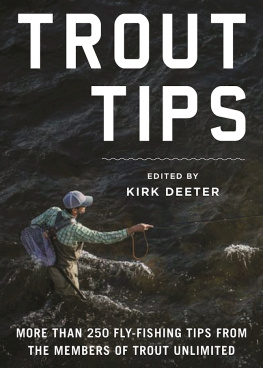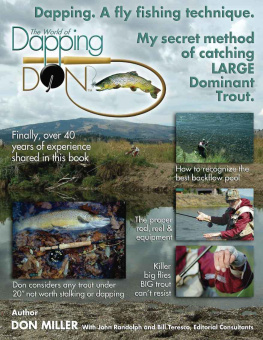SIMPLE FLY FISHING
TECHNIQUES FOR TENKARA AND ROD & REEL
Yvon Chouinard, Craig Mathews, and Mauro Mazzo
Foreword by Russell Chatham
Paintings by James Prosek

Ventura, California
One percent of the sales from this book go to the preservation and restoration of the natural environment. In addition, the authors are donating their entire profits from the sales of the first edition to the Native Fish Society, the Atlantic Salmon Federation, and 1% For The Planet. Finally, a portion of the proceeds is being donated to World Trout Initiative.

Contents

Photo: Mauro Mazzo
AT ITS MOST PROFOUND, FISHING IS A WAY OF REMAINING FOREVER A CHILD.
Russell Chatham
Foreword
T he fact is that fishing with an artificial fly has always been an elitist activity. Simply stated, the reason is that at its core lies a set of esthetic precepts rather fundamentally at odds with those of the common man whose approach to lifes various aspects is simple practicality. Be that as it may, at the end of the day fishing is still just fishing.
Going back to its origins in Europe, fly casting was practiced in the realm of the aristocracy who owned and controlled the trout and salmon waters appropriate to its use. However, in the literature there sometimes would appear poachers who fell in love with the esoteric essence of this enterprise, and who were willing to risk imprisonment for the sake of its sensual rewards, in one sense a bit like rogering the counts bored wife.
Once transposed to America it became a tad more democratic; but just a tad, as wealthy easterners commandeered private waters in the Catskills and Adirondacks and formed exclusive clubs in New York.
Enter the left coast where many regarded the right as some version of an anthropomorphic museum filled with taxidermied throwbacks, and where fly fishing was mainstream from the start among the great unwashed. In spite of this, it has degenerated into a country club activity popular with the nouveau riche in which the accoutrements have become so ridiculously complex and expensive that Joe Six-Pack can only stand helplessly with his nose pressed to the tackle store window.
One has to wonder how this happened. There are several very simple explanations. The first and most important is that because of our universal environmental crimes, weve ruined most of the fishing close to home: the all-important free fishing that youngsters could readily find after school on foot or by bike.
Because of this, in the late 1970s companies like Fishing International and Frontiers began booking exotic world travel directed at, but not exclusive to, fly fishermen. This changed the angling pastime precipitously. Now, instead of throwing your waders and rod into the trunk of the car and driving for an hour from San Francisco to the Russian River, you wrote a check for a thousand dollars a day to go to Alaska, British Columbia, South America, Iceland, or Russia.
It didnt take the tackle companies long to go on a high-alert point. Suddenly, rods didnt cost twenty-five dollars anymore. Now, instead of plebeian fiberglass, they were made of graphite or boron technology and could set you back four, five, or even six hundred dollars. And the gold- and silver-plated reels that had all the class of a three-dollar whores earrings were similarly priced. Alright Bucko, if you can afford eight or nine thousand dollars to wet a line for a week, you need the Right Stuff.
Its simple, greed-driven supply-side undemocratic capitalism doing what it does best, which is to demand more and more product and ever-increasing sales. Product lifespan is earmarked at the factory for the flea market, and the manufacturers will handle the public relations on that.
As the great rod designer and builder Tom Morgan has said over and over again, A good rod is a good rod whether it was made sixty years or sixty days ago. And in this he was echoing the sentiments of every knowledgeable and ethical fine craftsman. But thats not how you sell more rods. First, yesterdays must be categorized as inferior and obsolete. In its place you need some new chemical component with a technical sounding name and a guarantee to make you a better caster. I remember once about thirty years ago being in Dan Baileys Fly Shop in Livingston, Montana, when a tourist was considering buying a four-hundred-dollar fly rod. The sales associate at the time, Fred Terwilliger, suggested they go out on the train depot lawn across the street and cast it. Pretty soon they were back in the store and Fred said, Mister, you dont need a four-hundred-dollar rod, you need a fifty-dollar casting lesson.
With respect to fly lines, with the exception of a perfectly level one, which is useless, there are only three basic designs. The most traditional of these is the double taper. Historically, the reason for this was that when all lines were made of silk, you fished half the day with one end, and when it began to sink, you turned it around, greased up the new end and went back to fishing. The weight-forward taper has a heavier section toward the front, designed to fish at greater distances. You false cast this belly, as its called, then shoot it, pulling the thinner fly line out behind it. A shooting taper, or head, is generally thirty feet long, tied to monofilament, making it the ultimate tool for distance casting. The first two styles, often referred to as whole lines, are generally about ninety to a hundred feet in length. All of these either float, or else sink at varying speeds.
I recall quite clearly in the 1950s when Scientific Anglers introduced the first plastic lines (heretofore, fly lines were woven of silk, nylon, or Dacron fibers). They produced the three aforementioned styles in white, which floated, and dark green, which sank. They worked closely with, and listened to, one time world-record caster, Myron Gregory, who brought to the table all the physical knowledge of the R.L. Winston Rod Company (Rod Builder to the Champions) and the Golden Gate Angling and Casting Club, both in San Francisco.
A year or so ago, I went through a new Scientific Anglers catalogue. In it were pictured and described about eighty different fly lines. Eighty. It seems that a line good for Floridas west coast is all wrong for its east coast, and of course neither are suitable for the Keys. And the line thats correct for Chesapeake Bay will not do for the Jersey Shore, and of course is also dead wrong for the flats around Nantucket. And dont get the idea that you can transpose your British Columbia steelhead line to Icelands Atlantic salmon rivers. How nave can you get? And so on until the minutiae becomes a spinning top whirling to the kachinging of the cash register.
The all-time perfect system in distance casting for steelhead and salmon as well as tournament events was developed in San Francisco in the 1940s and perfected in the 1950s. It was simply a thirty-foot shooting head for fishing, and fifty for competition, backed by nylon monofilament. Early on, this material was very hard to handle, being wiry and easily tangled. Eventually however, the Sunset Line and Twine Company in Petaluma, California, developed a brand they called Amnesia that eliminated those problems.



